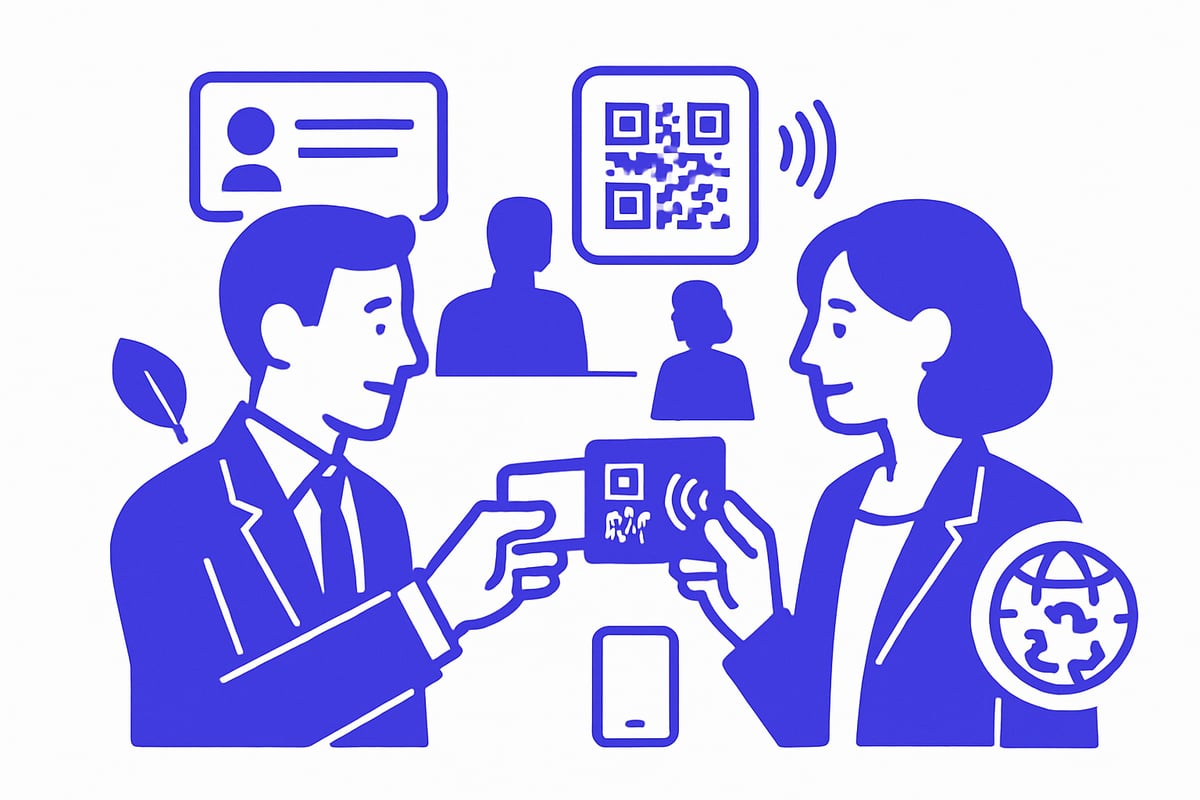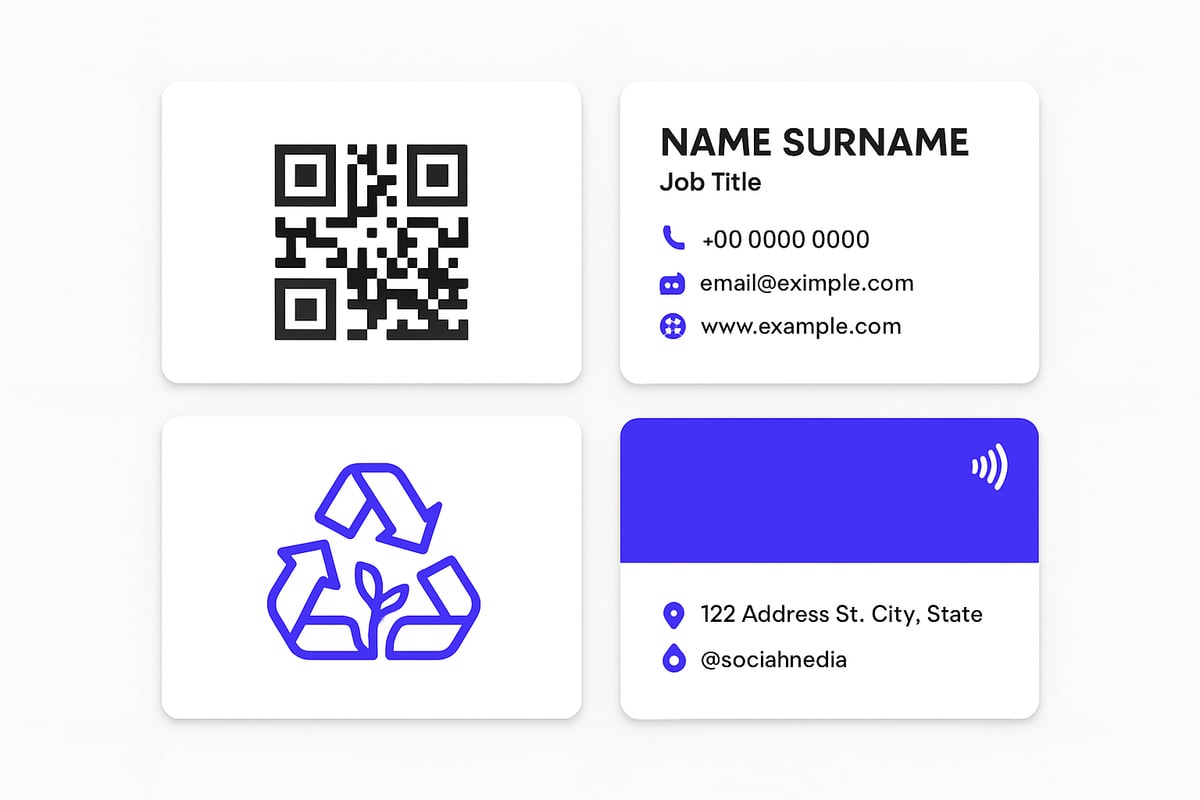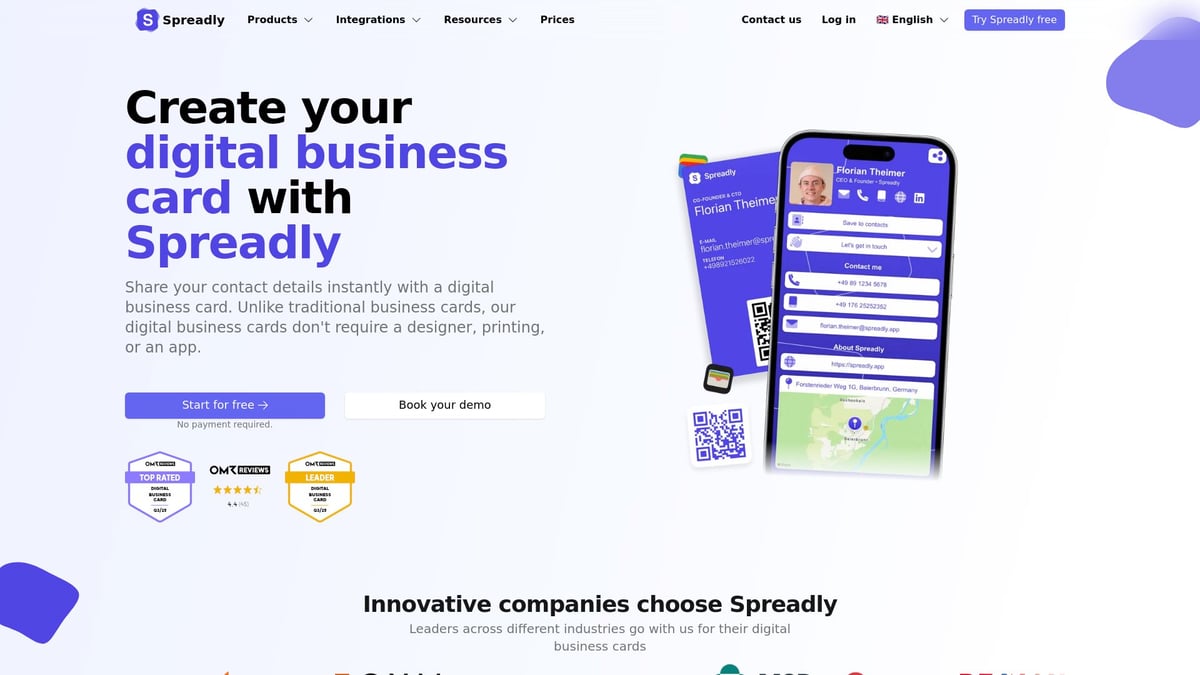The Essential Guide to Networking Business Card Success 2025
15 minutes
11th of October 2025
In this article:
- The Evolution of Networking Business Cards in 2025
- Designing the Perfect Networking Business Card
- Integrating Digital Business Cards for Seamless Networking
- Making Your Business Card Work: Distribution and Usage Strategies
- Measuring Networking Business Card ROI and Effectiveness
- Future-Proofing Your Networking: Trends and Innovations for 2025 and Beyond
Did you know that in 2025, over 70% of professionals still credit in-person networking for their most valuable career connections? Despite the dominance of digital communication, the networking business card continues to be a vital tool, adapting to new formats and expectations.
This essential guide will show you how to master every aspect of networking business card success in 2025. Discover the latest trends, design strategies, digital integration tips, distribution tactics, and future-proofing insights. Ready to elevate your professional impact? Let’s get started.
The Evolution of Networking Business Cards in 2025
The landscape of the networking business card is transforming rapidly in 2025. As professionals seek meaningful connections, the classic paper card is no longer the sole option. Today, innovative solutions blend tradition with technology, paving the way for more sustainable, efficient, and interactive networking experiences.

The Shift from Traditional to Modern Formats
The networking business card is undergoing a profound transition from purely physical cards to versatile digital and hybrid formats. NFC-enabled cards, QR code integration, and fully virtual cards are now commonplace. This shift is driven by growing sustainability concerns, increased remote networking, and a surge in technology adoption.
Recent industry surveys indicate that over 37% of professionals have adopted digital cards in 2025, a figure that continues to rise each year. According to Digital Business Card Adoption Statistics, businesses are embracing digital options for their eco-friendly attributes and seamless sharing capabilities.
Global events such as the pandemic have accelerated remote work and virtual meetings, making digital networking business card solutions essential. However, physical cards remain relevant at in-person events, offering a tactile experience that supports memorable first impressions. When comparing effectiveness, digital cards often capture leads more efficiently, while traditional cards still play a crucial role in face-to-face interactions.
| Format | Lead Capture Efficiency | Sustainability | Best Use Case |
|---|---|---|---|
| Physical | Medium | Low | In-person events |
| Digital | High | High | Virtual/hybrid events |
| Hybrid (NFC/QR) | High | Medium/High | All scenarios |
Key Trends Shaping Business Card Networking
In 2025, the networking business card reflects both simplicity and innovation. Minimalist layouts with bold accents dominate, ensuring information is clear and impactful. Interactive elements like embedded QR codes, AR features, and even short videos are becoming standard, providing recipients with instant access to portfolios or scheduling tools.
Personal branding is at the forefront, with customization options tailored for specific industries. Integration with CRM and networking apps streamlines follow-ups and data management. Eco-friendly materials, such as recycled paper and print-on-demand services, are increasingly preferred, reducing environmental impact.
Popular platforms like Canva and Vistaprint offer templates that highlight these trends, allowing professionals to design cards that align with their brand identity. Businesses leverage these tools to maintain consistency while enabling individual customization for team members.
The Business Card’s Role in Multichannel Networking
The networking business card is now a gateway to a broader digital presence. Whether at hybrid conferences, webinars, or virtual meetups, professionals use cards to connect attendees with online profiles, portfolios, or booking pages. The frequency of card exchanges at virtual events has grown, matching or even surpassing some live gatherings.
For example, a tech startup recently combined digital and print cards to enhance their reach. By offering QR code-enabled cards at trade shows while sharing digital versions during webinars, they increased new connections by 32% within one quarter.
This multichannel approach ensures that the networking business card remains a vital tool, adapting to the evolving ways professionals meet and collaborate in 2025.
Designing the Perfect Networking Business Card
A well-designed networking business card is more than a tool—it is your professional handshake in print or digital form. In 2025, card design is a strategic asset that shapes first impressions and opens doors to lasting business relationships.
The perfect networking business card distills your personal brand and core information into a format that is visually impactful, easy to share, and ready for both physical and digital environments. Let’s explore how to design a card that stands out and works hard for you.

Essential Elements of High-Impact Cards
Every networking business card should clearly communicate who you are and how to connect with you. The essentials include:
- Full name (easy to read, prominent position)
- Job title and company (aligned with your personal brand)
- Contact information (email, phone number, location if relevant)
- Social media handles (LinkedIn, Twitter, or industry-specific networks)
- Website or portfolio link (for deeper engagement)
Clarity and legibility are non-negotiable. Use straightforward language and avoid clutter. Your networking business card should balance personal branding with any required company branding, ensuring the message is concise and memorable.
For inspiration, platforms like Canva and Vistaprint offer templates designed to highlight these core elements. Their layouts guide the eye and keep details organized, so your card delivers impact at a glance.
A networking business card with a clean structure and thoughtful information makes follow-up easy, increases trust, and sets the stage for meaningful connections.
Visual Design Best Practices for 2025
Visual appeal is a powerful credibility booster. In fact, 60% of recipients judge credibility by business card design, according to print industry reports. In 2025, the leading design trends are minimalist layouts, bold color palettes, and accessible typography.
Key visual strategies:
- Color palette: Choose colors that align with your industry and brand values. Finance and technology lean toward cool blues and grays, while creative fields may use vibrant accents.
- Typography: Bold, readable fonts are in. Prioritize accessibility—avoid tiny or ornate fonts that hinder legibility.
- Branding: Integrate your logo and, if appropriate, a professional headshot for personal touch.
- Whitespace: Use generous spacing to highlight key details and prevent visual overload.
- Interactive elements: Add QR codes or subtle icons for digital engagement.
A well-crafted design signals professionalism and attention to detail. The rise of digital business cards is also influencing visual expectations—dynamic, interactive features like embedded videos or AR elements are gaining ground. For more on these trends and adoption rates, see Digital Business Card Market Growth Projections.
Material and Finish Selection
The tactile quality of your networking business card still matters, especially for in-person events. Card stock and finishes influence how your card feels and how long it lasts.
Popular options:
- Matte: Smooth, non-reflective, modern.
- Glossy: High-shine, vibrant colors, but fingerprints show easily.
- Textured: Linen or cotton surfaces add sophistication.
- Recycled: Eco-friendly and increasingly preferred.
Special finishes:
- Foil accents: Metallic highlights for logos or names.
- Embossing: Raised details for tactile interest.
- Spot UV: Glossy highlights on matte backgrounds.
- Soft touch: Velvet-like coating for a premium feel.
Shapes: Beyond the standard rectangle, consider rounded corners, square, or mini cards for extra impact.
Sustainability is a top concern in 2025. Many professionals choose recyclable or biodegradable options, reflecting their values on their networking business card.
Interactive and Digital-Ready Designs
Modern networking business cards bridge the gap between print and digital. Embedding a QR code links recipients directly to your online profile or portfolio, making follow-up seamless.
NFC-enabled cards are also on the rise. A quick tap can transmit your contact info instantly, perfect for tech-savvy audiences. These interactive features not only impress but also double your chances of capturing leads, as shown by professionals who have integrated QR codes and seen LinkedIn connections soar.
Tips for digital-ready cards:
- Link to a landing page, video introduction, or scheduling tool.
- Test QR codes for reliability and speed.
- Use platforms that allow easy updates, so your networking business card always reflects your latest details.
In 2025, the best networking business card is one that combines timeless clarity with innovative technology, ensuring you are remembered and reconnected with—every time.
Integrating Digital Business Cards for Seamless Networking
In 2025, integrating digital solutions into your networking business card strategy is no longer optional. As professional connections span both virtual and real-world environments, understanding how to leverage digital and physical cards together can dramatically increase your reach and impact. Let’s explore how to make your networking business card work harder for you in every scenario.
Digital vs. Physical: When and Why to Use Each
Choosing between a digital and physical networking business card depends on your context and audience. Digital cards offer instant sharing, easy updates, and analytics, making them ideal for virtual events, remote meetings, and global connections. Physical cards remain essential for in-person trade shows, local networking, and situations where tactile impressions matter.
| Feature | Digital Cards | Physical Cards |
|---|---|---|
| Update Info | Instantly, online | Reprint required |
| Lead Capture | Automated, analytics | Manual, limited tracking |
| Eco-Friendly | Paperless, sustainable | Depends on materials |
| Sharing | QR/NFC/Link, remote | Hand-to-hand, in-person |
Recent research shows that over 60% of professionals have adopted digital cards, reflecting a surge in demand for hybrid solutions. According to the Digital Business Cards Industry Report 2025-2030, rapid digitalization is reshaping how networking business card platforms are used worldwide. Combining both formats ensures you are prepared for any networking environment.
Features to Look for in Digital Business Card Platforms
Selecting the right digital platform for your networking business card is crucial for long-term success. Look for these must-have features:
- Custom branding: Personalize cards to reflect your unique or company brand.
- Multiple sharing methods: QR codes, NFC tap, direct links, wallet app compatibility, and email.
- Lead capture and CRM integration: Sync new contacts seamlessly with Salesforce, HubSpot, or other tools.
- Security and privacy: Ensure GDPR compliance and robust data protection.
- Rich media: Embed videos, files, or interactive backgrounds to stand out.
A powerful networking business card platform should empower you to automate updates, manage teams, and track engagement across channels. This flexibility allows you to adapt your networking business card strategy as trends evolve.
Spreadly: The Modern Digital Business Card Solution
Spreadly is redefining what a networking business card can do in 2025. The platform offers fully customizable digital cards, instantly shareable via QR codes, NFC, links, and wallet apps. You can embed videos, files, and interactive elements, making every interaction memorable.

With seamless integration for HR and CRM systems like Salesforce, HubSpot, Microsoft Dynamics, and BambooHR, Spreadly streamlines contact management for individuals and teams. Centralized branding, automated card creation, and detailed engagement analytics help organizations maintain a consistent networking business card experience.
Setup is fast, and recipients do not need an app. Spreadly is GDPR-compliant and trusted by leading brands including American Express GBT, TeamViewer, and Volkswagen Financial Services. Whether you are a solo professional or part of a global enterprise, Spreadly offers a scalable, efficient solution for networking business card success.
Maximizing Engagement with Digital Cards
To get the most from your networking business card, share it proactively at events, include it in your email signature, and post it on social media. Use built-in analytics to monitor opens, shares, and follow-up actions, then sync contacts directly to your CRM for streamlined lead management.
Companies report up to 38% more engagement and 630% more follow-ups when using digital networking business card solutions. By tracking every interaction, you can refine your approach and ensure that each card exchange leads to a lasting connection.
Making Your Business Card Work: Distribution and Usage Strategies
Maximizing the impact of your networking business card requires more than just great design. Strategic distribution and smart usage ensure your card leads to meaningful connections, whether you are at a conference, on a video call, or following up with a new prospect. Let’s explore actionable strategies to help your networking business card work harder for you in every professional setting.

Strategic Distribution at Events and Meetings
Presenting your networking business card at the right moment can set the tone for a lasting professional relationship. When attending events or meetings, timing and etiquette matter. Offer your card after a meaningful exchange, not as an introduction. This approach ensures your networking business card feels like a valuable takeaway rather than an afterthought.
Consider these tips for effective distribution:
- Wait for a natural pause in the conversation before offering your card.
- Use both hands when presenting your card in cultures where this is customary.
- Carry a dedicated card holder to keep your cards pristine and easily accessible.
Physical cards still make a strong impression at in-person events. For digital cards, have your QR code or NFC card ready on your smartphone. The right presentation method can make your networking business card memorable and professional.
Networking Beyond Events: Everyday Opportunities
Your networking business card is a versatile tool that extends beyond conferences and trade shows. Look for daily opportunities to share it, such as including it in direct mail campaigns, thank-you notes, or product shipments. Embedding digital cards in your email signature or virtual backgrounds during online meetings keeps your contact info accessible at all times.
Sustainability is top of mind for many professionals. By adopting digital cards, you not only expand your reach but also contribute to reducing paper waste. For more on this topic, see the environmental impact of digital business cards and how they support eco-friendly networking. This approach makes your networking business card relevant in both physical and digital settings.
Leveraging Technology for Efficient Sharing
Technology has made sharing your networking business card faster and more efficient. Mobile apps allow you to scan and store received cards instantly, reducing the risk of losing valuable contacts. NFC and QR code-enabled cards enable contactless sharing, which is especially useful for health-conscious or remote networking scenarios.
Integrate your new contacts directly into your CRM or phone. This seamless process helps you keep track of your growing network. Whether you are sharing a paper card or a digital profile, leveraging technology ensures your networking business card delivers value long after the initial exchange.
Following Up: Turning Card Exchanges into Lasting Connections
The real power of your networking business card lies in what happens after the exchange. Prompt and personalized follow-up can turn a brief encounter into a lasting professional relationship. Reference your previous interaction in your message, and use links embedded in your card to schedule meetings or calls easily.
Segment your new contacts to tailor your outreach. Nurture leads by sharing relevant resources or updates, keeping your connection active. By making follow-up a priority, your networking business card becomes the starting point for genuine, productive networking.
Measuring Networking Business Card ROI and Effectiveness
Tracking the return on investment (ROI) of your networking business card strategy is crucial in 2025. With so many professionals exchanging cards at both digital and in-person events, understanding what works helps you refine your approach and maximize your results.
Tracking Card Performance and Engagement
Measuring the effectiveness of your networking business card starts with clear, actionable metrics. The most common indicators include the number of cards distributed, follow-up contacts, and conversion rates from initial connection to meaningful engagement.
Digital business cards provide advanced analytics. You can track how often your card is opened, shared, or leads to a website visit. This data offers insights that were impossible with traditional paper cards. For example, tracking which events generate the most card interactions helps you prioritize future networking opportunities.
A recent case study highlights the power of analytics. A consulting firm used digital cards and saw a 42% increase in lead follow-ups compared to previous years. They attributed this to real-time engagement tracking and targeted follow-up strategies. By focusing on what the data revealed, they made smarter networking decisions.
If you want to optimize your networking business card strategy, consistently monitor these metrics. The more you know about your card’s performance, the better you can adapt to changing networking environments.
Tools and Techniques for ROI Analysis
To accurately measure ROI, integrate your networking business card data with CRM and marketing automation platforms. This enables automatic syncing of new contacts and helps track their journey from initial meeting to potential client.
A/B testing different card designs or sharing methods reveals what resonates with your audience. For instance, you might compare a minimalist design against one with interactive QR codes to see which drives more engagement. Surveys and feedback forms also provide valuable qualitative data.
Here’s a summary of useful tools:
| Tool Type | Example Platforms | Key Benefit |
|---|---|---|
| CRM Integration | Salesforce, HubSpot | Contact and lead tracking |
| Analytics | Google Analytics, Spreadly | Engagement measurement |
| A/B Testing | Optimizely, custom scripts | Design optimization |
| Survey Tools | Typeform, Google Forms | User feedback collection |
With the right tools, your networking business card can become a measurable driver of business growth.
Common Pitfalls and How to Avoid Them
Even the best networking business card can fall short if you overlook key details. Common pitfalls include overdesigning your card, cluttering it with too much information, or using outdated contact details.
Another frequent mistake is failing to follow up with new connections. The initial exchange means little if you do not continue the conversation.
To avoid these issues, follow this checklist:
- Keep your card design clean and concise
- Update contact information regularly
- Track all new contacts and schedule timely follow-ups
- Use analytics to measure engagement and refine your strategy
By sidestepping these pitfalls, your networking business card will remain an effective tool for building lasting professional relationships.
Future-Proofing Your Networking: Trends and Innovations for 2025 and Beyond
As the professional landscape evolves, future-proofing your networking business card strategy is essential for ongoing success. New technologies, sustainability concerns, and changing event formats are reshaping how we connect. Staying ahead means adapting your approach to ensure your networking business card remains impactful and relevant.
Emerging Technologies and Business Card Innovations
The networking business card is rapidly evolving with the integration of advanced technologies. AI-powered lead capture tools now allow you to instantly sync contact details and automate follow-ups. Augmented reality (AR) business cards create interactive experiences, letting recipients scan your card to access videos or 3D models.
Blockchain technology is also entering the scene, offering secure and verifiable contact sharing. This ensures data integrity and builds trust during exchanges. These innovations are not just trends, but practical ways to enhance the networking business card for deeper, smarter connections.
| Technology | Benefit |
|---|---|
| AI Lead Capture | Automated syncing, reminders |
| AR Elements | Interactive engagement |
| Blockchain | Secure data sharing |
Sustainability and Ethical Networking Practices
Sustainability is now a top priority for every networking business card. Eco-friendly materials, such as recycled paper or biodegradable plastics, are increasingly popular. There is also a significant shift toward digital-first approaches, which reduce waste and carbon footprints.
Ethical considerations are equally important. Data privacy and consent must be respected when sharing and storing contact information. Companies are adopting responsible networking practices, ensuring their networking business card strategies align with both environmental and regulatory standards.
| Practice | Impact |
|---|---|
| Recycled Materials | Reduces waste |
| Digital Cards | Lowers environmental cost |
| Data Privacy Compliance | Builds trust |
Preparing for the Next Wave of Networking
Adapting to hybrid and virtual events is crucial for maximizing the reach of your networking business card. As conferences and meetings blend online and offline interaction, your card must support both environments. Building a personal brand that stands out across formats will help you remain memorable.
Continuous learning is vital. Stay updated on the latest design trends, tech integrations, and etiquette to keep your networking business card relevant. Consider subscribing to industry newsletters or joining professional groups for ongoing education.
- Attend hybrid events with both physical and digital cards
- Update card designs to reflect current trends
- Invest in learning about new networking tools
Action Steps for Ongoing Networking Success
To ensure your networking business card strategy remains effective, commit to regular reviews and updates. Analyze analytics from digital cards to understand engagement and refine your approach. Invest in platforms and tools that align with your evolving networking objectives.
Set a recurring reminder to audit your networking business card every quarter. Monitor performance metrics and adjust your design or distribution methods as needed. With these proactive steps, your networking business card will continue to open doors and create meaningful professional relationships.
Whether you are looking to make a memorable impression at your next event or want an easy way to keep your professional connections up to date, embracing digital business cards can transform your networking in 2025. With tools like Spreadly, you can create a modern, customizable card that is always current and ready to share, saving you time and helping you capture more leads. Ready to see how effortless and impactful digital networking can be? You can experience all these features for yourself—no commitment required. Simply try for free and take your networking to the next level.






